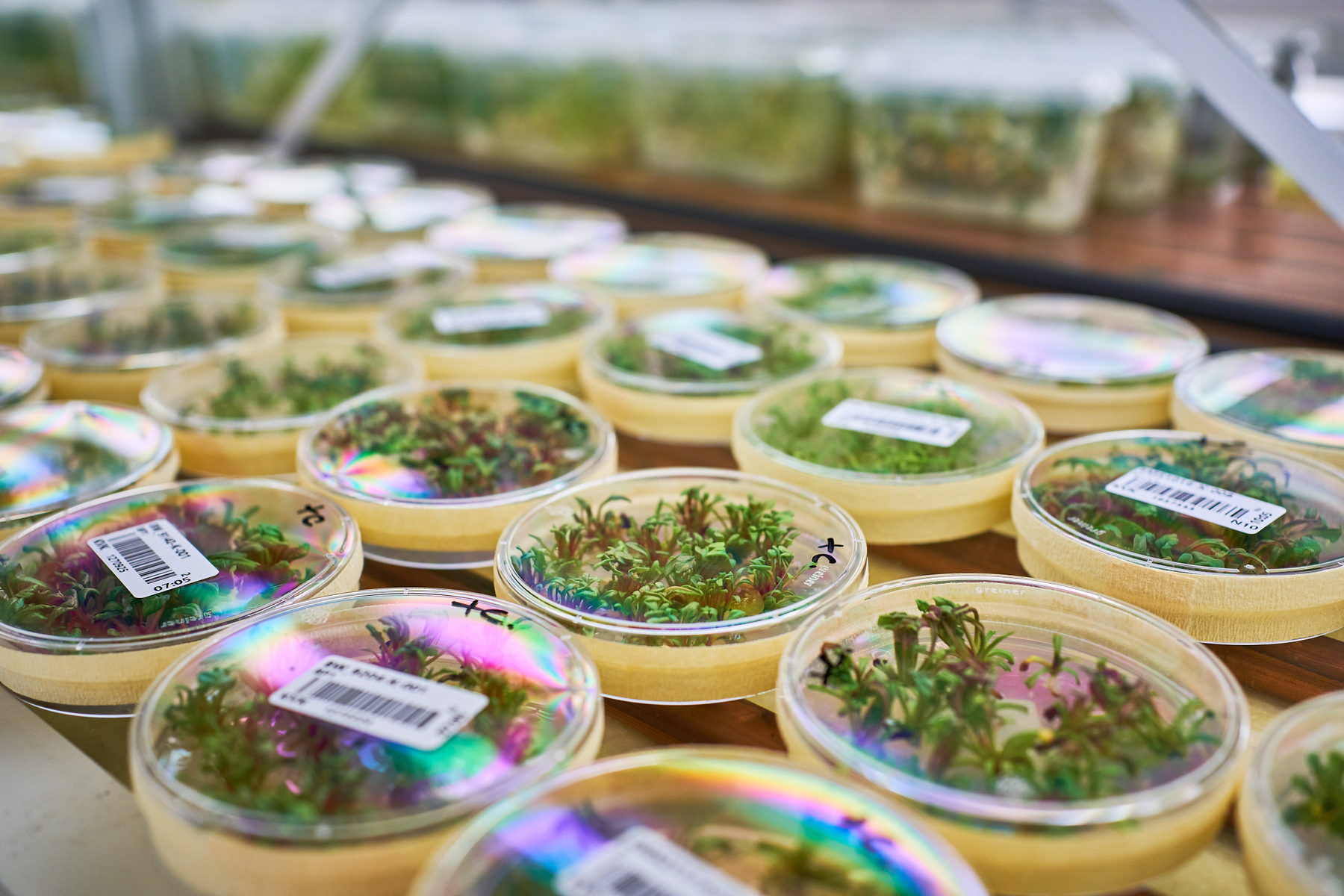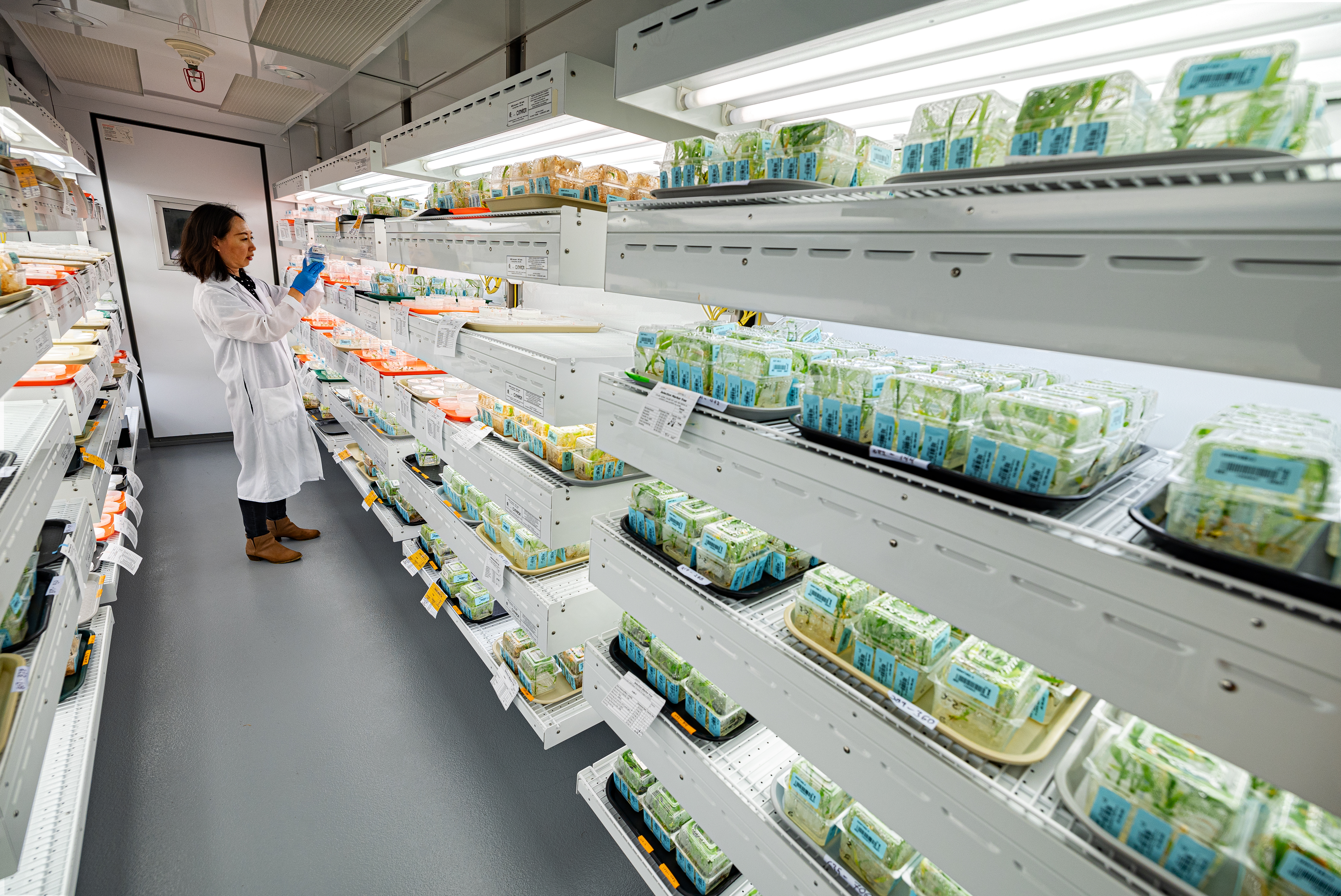KWS agricultural trait catalogue for licensing agreements
Browse our native traits here
Background: Cercospora leaf spot is one of the most important, globally prevalent fungal leaf diseases of plants from the species Beta vulgaris. Plants infested by this disease typically form small, relatively round leaf spots (2-3 mm) that are light gray in the middle and are surrounded by a red-brown border. In a severe infestation, the leaf spots overlap, so that entire portions of the leaf blade dry out.
Subject matter of the license: The subject matter of the license relates to seeds of Beta vulgaris ssp. vulgaris plants having a resistance against Cercospora beticola. The subject matter of the license also includes different marker-based methods for detection of Cercospora resistant Beta vulgaris ssp. vulgaris plants and respective marker.
Click here to view this trait at the official European Patent Register
Background: In maize (Zea mays) there are a large number of fungal pathogens known which cause leaf diseases. The fungus which can cause by far the most damage is known as Helminthosporium turcicum or synonymously as Exserohilum turcicum. H. turcicum results in the leaf spot disease known as "Northern Corn Leaf Blight" (NCLB), which can occur in epidemic proportions during wet years, attacking vulnerable maize varieties and causing a great deal of damage and considerable losses of yield of 30% and more over wide areas.
Subject matter of the license: The subject matter of the license relates to a maize plant having a novel Helminthosporium turcicum resistance. This resistant plant contains a chromosomal fragment on chromosome 8 derived from the accession Pepitilla leading to HTN1 resistance and can be molecular characterized by specific markers.
Click here to view this trait at the official European Patent Register
Background: In maize (Zea mays) there are a large number of fungal pathogens known which cause leaf diseases. The fungus which can cause by far the most damage is known as Helminthosporium turcicum or synonymously as Exserohilum turcicum. H. turcicum results in the leaf spot disease known as "Northern Corn Leaf Blight" (NCLB), which can occur in epidemic proportions during wet years, attacking vulnerable maize varieties and causing a great deal of damage and considerable losses of yield of 30% and more over wide areas.
Subject matter of the license: The subject matter of the license relates to marker-based detection methods for a maize plant having an increased resistance to Exserohilum turcicum. This increased resistance is linked to the presence of a QTL allele located on chromosome 4 (HTM) in a maize plant.
Click here to view this trait at the official European Patent Register
Background: Phoma stem canker also known as Blackleg, caused by the fungal pathogen(s) L. maculans and/or L. biglobosa, is a major disease of a wide variety of Brassica crops including B. napus L. (oilseed rape or Canola) and Brassica oleracea (cabbage), leading to the lodging of plants and plant death. Blackleg is causing annually major economic losses worldwide, in particular in Europe, Australia, Canada and North America.
Subject matter of the license: The subject matter of the license relates to marker-based detection methods and respective markers for plants having Phoma stem canker resistance and reduced linkage drag.
Click here to view this trait at the official European Patent Register
Background: Cercospora leaf spot is one of the most important, globally prevalent fungal leaf diseases of plants from the genus Beta or Spinacia. Plants infested by this disease typically form small, relatively round leaf spots (2-3 mm) that are light gray in the middle and are surrounded by a red-brown border. In a severe infestation, the leaf spots overlap, so that entire portions of the leaf blade dry out.
Subject matter of the license: The subject matter of the license relates to marker-based methods for the detection of plants from the genus Beta or Spinacia having a resistance to Cercospora.
Click here to view this trait at the official European Patent Register
Background: Rhizomania is the most serious sugar beet disease worldwide in terms of profitability and may cause earning losses of 50% and more. The disease is caused by the “Beet Necrotic Yellow Vein Virus” (BNYVV). Since a curative combatting of the disease is not possible, as is the case with other viral diseases, damage can be prevented only via the cultivation of resistant species.
Subject matter of the license: The subject matter of the license relates to a method of detecting a nucleic acid molecule in plants which encodes a protein conferring the BNYVV resistance called Rz2/3 to the plant. Furthermore, the subject matter relates also to specific molecular markers.
Click here to view this trait at the official European Patent Register
Background: Rhizomania is the most serious sugar beet disease worldwide in terms of profitability and may cause earning losses of 50% and more. The disease is caused by the “Beet Necrotic Yellow Vein Virus” (BNYVV). Since a curative combatting of the disease is not possible, as is the case with other viral diseases, damage can be prevented only via the cultivation of resistant species.
Subject matter of the license: The subject matter of the license relates to BNYVV-resistant plants in which the resistance is conferred by one or more mutations into the endogenous Rz1 gene. The subject matter of the license further relates to a method of detecting such BNYVV-resistant plants of the genus Beta.
Click here to view this trait at the official European Patent Register
Background: The beet cyst nematode is a plant pathogenic nematode and can cause considerable yield loss not only in sugar beets but also in other beets such as red beet, fodder beet and chard, as well as in other plants of the family Amaranthaceae by severely damaging root systems.The spread of the disease is continuous, and the pest has become increasingly difficult for growers to manage. So far, the most effective method for decreasing the nematode soil population was growing resistant sugar beet varieties.
Subject matter of the license: The subject matter of the license relates to a method of detecting a Beta vulgaris plant being resistant against a nematode of the genus Heterodera.
Click here to view this trait at the official European Patent Register
Background: The optimal growth temperature for the germination of maize seeds and the development of maize plants is between 21-27° C. Thus, stress already occurs below temperatures of 20° C., which is a typical temperature in Northern Europe during planting times. Mild chilling stress with reduced photosynthesis in light and reduced growth is seen at 12-17° C., and severe chilling stress occurs together with cold-induced water stress, a type of drought stress, in light at 2-10° C.
Subject matter of the license: The subject matter of the license relates to a novel chill-tolerant plant as well as to the detection of such a chill-tolerant plant using specific markers for an interval on chromosome 4.
Click here to view this trait at the official European Patent Register
Background: Plants are provided that exhibit a homozygous nucleus-encoded male sterile phenotype through spontaneous mutation of a gene region in the nucleus genome. As such these plants can contribute to simplifying labor-intensive breeding programs.
Subject matter of the license: The subject matter of the license relates to a male sterile sugar beet plant having a nucleus-encoded, recessive, male sterile phenotype through mutation in a DNA segment comprising a cytochrome P450 oxidase (CYPgst). The subject matter of the license further includes a method for detecting such male sterile sugar beet plants.
Click here to view this trait at the official European Patent Register
Background: Cytoplasmic male sterility (CMS) is applied in plant breeding programs worldwide to inhibit self-pollination of female lines in hybrid production. It is characterized by maternally inherited mutations, which result in plants that are unable to produce pollen. In order to ensure that the hybrid progeny is entirely fertile and able to produce seeds, male parental lines in hybrid production need to possess so called restorer genes, which cover and cancel the effects of CMS.
Subject matter of the license: The subject matter of the license relates to plants having a cytoplasmatic male sterility restorer on chromosome 3. Furthermore, the subject matter encompasses markers and a marker-based detection method for a respective maize restorer haplotype.
Click here to view this trait at the official European Patent Register
Background: Because of its pronounced stress tolerance in nutrient-deficient, dry locations as well as in catchment areas with limited pesticide use, rye exhibits substantial yield advantages compared with barley and wheat, and thus holds specific promise for sustainable agriculture. The use of cytoplasmic male sterility (CMS) in rye has opened up the possibility of breeding hybrid varieties with high yield potentials by exploiting heterosis. In order to ensure that the hybrid progeny is entirely fertile and able to produce seeds, male parental lines in hybrid production need to possess so called restorer genes, which cover and cancel the effects of CMS.
Subject matter of the license: The subject matter of the license relates to plants (especially Poaceae) which can restore Pampa cytoplasmic male sterility (CMS) as male pollen parent. Furthermore, the subject matter of the license relates to marker-based detection methods.
Click here to view this trait at the official European Patent Register
Background: Improving digestibility is a major goal for forage breeding programs in maize, which is the most important annual forage crop in the world. More than 3 million hectares of maize are ensiled each year, mainly in Northern Europe. Due to high energy content and feed conversion efficiency, the forage maize is an important food crop for dairy and beef cattle, and is affecting significantly the milk and meat production. There is a wide genetic variation in forage characteristics for both the entire maize plant and stover.
Subject matter of the license: The subject matter of the license relates to a maize plant with improved digestibility caused by a QTL comprising a cytochrome P450 flavonoid 3`,5´-hydroxylase (F35H) gene having a mutation leading to a non-functional protein or a protein with reduced enzymatic activity. Furthermore, the subject matter of the license relates to a detection method including the usage of specific markers.
Non-Asserts: KWS will not assert the patent comprising this trait in the validated Member States of the European Patent Organisation (“EPO”) to the extent it refers to i) “Pass-Through” Claims, i.e. ensilaged plant material or animal feed and its respective production method as described in claims 13, 14 and 15, ii) Scope of Marker Application for All Breeders, i.e. claim 1 in so far as it concerns screening for the presence of a marker allele in maize plants or plant parts of maize with an improved digestibility using markers, which identify marker alleles located outside of certain intervals, all of the foregoing as described in more detail in the Non-Assert All Breeders and/or iii) Extended Scope of Marker Application for Small Breeding Companies as described in more detail in the Non-Assert Small Breeding Companies.
In order to benefit from the aforementioned Non-Asserts, please fill in, sign and send back to KWS the following documents: Non-Assert “Pass-Through” Claims, Non-Assert All Breeders and/or Non-Assert Small Breeding Companies, as applicable.
Click here to view this trait at the official European Patent Register
Found the trait you were looking for?
Download, fill-in, sign and send us the Standard Breeders License document to gain cost-free access to the trait for breeding purposes. Should you wish to start commercial activities with the respective trait, download our Standard Commercial License Agreement to see the applicable general license conditions. Please reach out for entering into bilateral Royalty negotiations for the respective native trait(s) of interest. Once there is an agreement on Royalties, the Standard Commercial License Agreement can be signed and selling own varieties featuring the KWS native traits can start.
In case you would like to benefit from the Non-Asserts regarding the “Digestibility Maize” trait as described in the catalogue, please download, fill-in, sign and send us the acknowledgements of the Non-Assert “Pass-Through” Claims, Non-Assert All Breeders and/or Non-Assert Small Breeding Companies, as applicable.
For access to traits not listed in our catalogue, please reach out directly via the contact option below.
Discover more
Your contact persons
Questions related to our traits, the contractual elements or the KWS licensing approach? Please reach out to:





